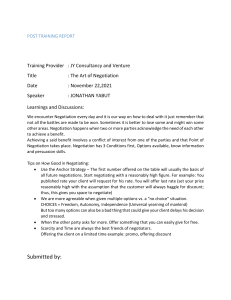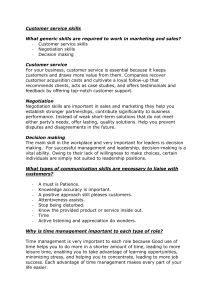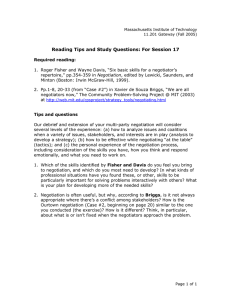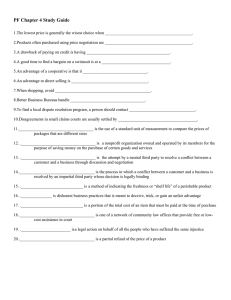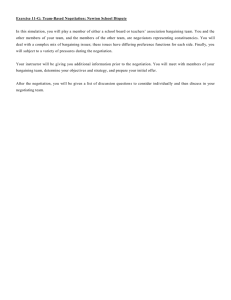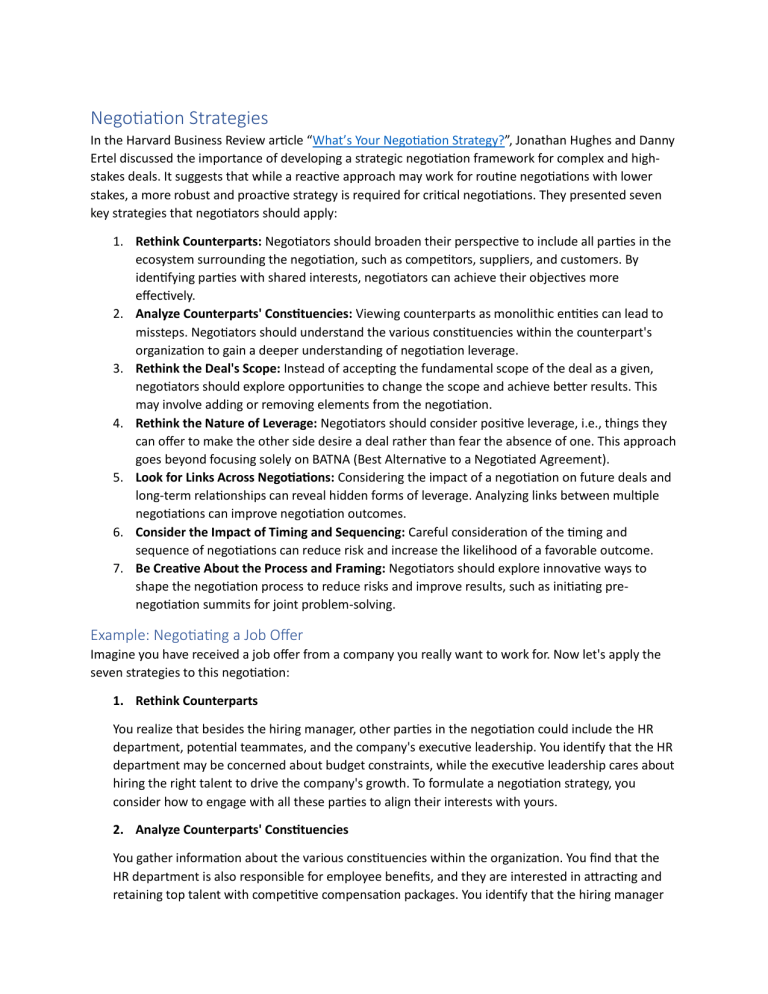
Negotiation Strategies In the Harvard Business Review article “What’s Your Negotiation Strategy?”, Jonathan Hughes and Danny Ertel discussed the importance of developing a strategic negotiation framework for complex and highstakes deals. It suggests that while a reactive approach may work for routine negotiations with lower stakes, a more robust and proactive strategy is required for critical negotiations. They presented seven key strategies that negotiators should apply: 1. Rethink Counterparts: Negotiators should broaden their perspective to include all parties in the ecosystem surrounding the negotiation, such as competitors, suppliers, and customers. By identifying parties with shared interests, negotiators can achieve their objectives more effectively. 2. Analyze Counterparts' Constituencies: Viewing counterparts as monolithic entities can lead to missteps. Negotiators should understand the various constituencies within the counterpart's organization to gain a deeper understanding of negotiation leverage. 3. Rethink the Deal's Scope: Instead of accepting the fundamental scope of the deal as a given, negotiators should explore opportunities to change the scope and achieve better results. This may involve adding or removing elements from the negotiation. 4. Rethink the Nature of Leverage: Negotiators should consider positive leverage, i.e., things they can offer to make the other side desire a deal rather than fear the absence of one. This approach goes beyond focusing solely on BATNA (Best Alternative to a Negotiated Agreement). 5. Look for Links Across Negotiations: Considering the impact of a negotiation on future deals and long-term relationships can reveal hidden forms of leverage. Analyzing links between multiple negotiations can improve negotiation outcomes. 6. Consider the Impact of Timing and Sequencing: Careful consideration of the timing and sequence of negotiations can reduce risk and increase the likelihood of a favorable outcome. 7. Be Creative About the Process and Framing: Negotiators should explore innovative ways to shape the negotiation process to reduce risks and improve results, such as initiating prenegotiation summits for joint problem-solving. Example: Negotiating a Job Offer Imagine you have received a job offer from a company you really want to work for. Now let's apply the seven strategies to this negotiation: 1. Rethink Counterparts You realize that besides the hiring manager, other parties in the negotiation could include the HR department, potential teammates, and the company's executive leadership. You identify that the HR department may be concerned about budget constraints, while the executive leadership cares about hiring the right talent to drive the company's growth. To formulate a negotiation strategy, you consider how to engage with all these parties to align their interests with yours. 2. Analyze Counterparts' Constituencies You gather information about the various constituencies within the organization. You find that the HR department is also responsible for employee benefits, and they are interested in attracting and retaining top talent with competitive compensation packages. You identify that the hiring manager wants to build a strong team, and your potential teammates want to work with someone who adds value to the group. Armed with this knowledge, you can customize your negotiation approach to address the concerns of each group. 3. Rethink the Deal's Scope Beyond the basic salary, you explore other aspects of the job offer. You discuss opportunities for professional development, such as training programs or attending industry conferences, and explore the possibility of a flexible work arrangement. By broadening the scope of the negotiation, you can create a more comprehensive package that meets both your personal and professional needs. 4. Rethink the Nature of Leverage You acknowledge that you have other job offers on the table, giving you some leverage in the negotiation. However, instead of emphasizing this fact, you focus on your passion for the company's mission, your relevant skills and experience, and your commitment to contributing to the company's success. By showcasing your enthusiasm and dedication, you create a positive impression and show the company that you are an asset. 5. Look for Links Across Negotiations You consider the potential for a long-term relationship with the company. You inquire about the company's career growth opportunities and express your interest in growing within the organization. By demonstrating your commitment to a long-term partnership, you show the company that investing in your development is mutually beneficial. 6. Consider the Impact of Timing and Sequencing You consider the company's hiring timeline and upcoming projects. You strategically time your negotiation to coincide with the company's decision-making process. You also inquire about the company's upcoming initiatives and express your willingness to contribute to those projects. By aligning your negotiation with the company's priorities, you increase the chances of reaching a favorable agreement. 7. Be Creative About the Process and Framing You propose a meeting with the hiring manager and HR representatives to discuss your potential role in the company in greater detail. During the meeting, you present ideas on how your skills and expertise can add value to the organization. By framing the negotiation as a collaborative discussion about mutual growth, you create a positive atmosphere that fosters creativity and openness to finding a win-win solution. By applying these seven strategies, you negotiate a job offer that not only meets your financial needs but also aligns with your career goals and provides a foundation for a fruitful long-term relationship with the company.
